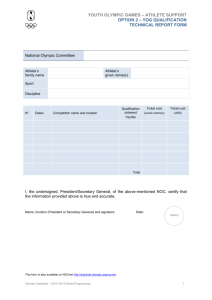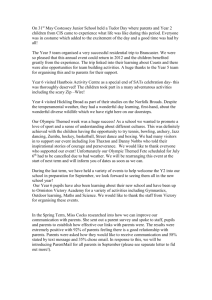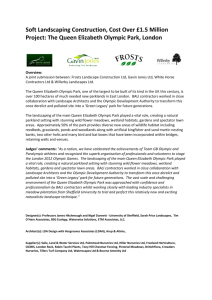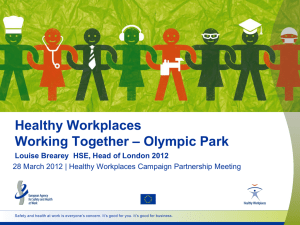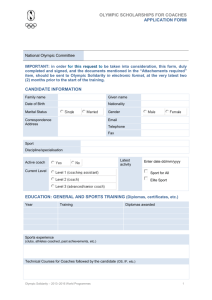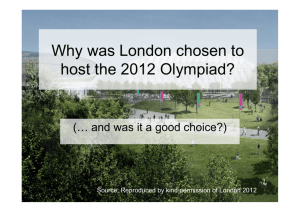Key facts and figures
advertisement
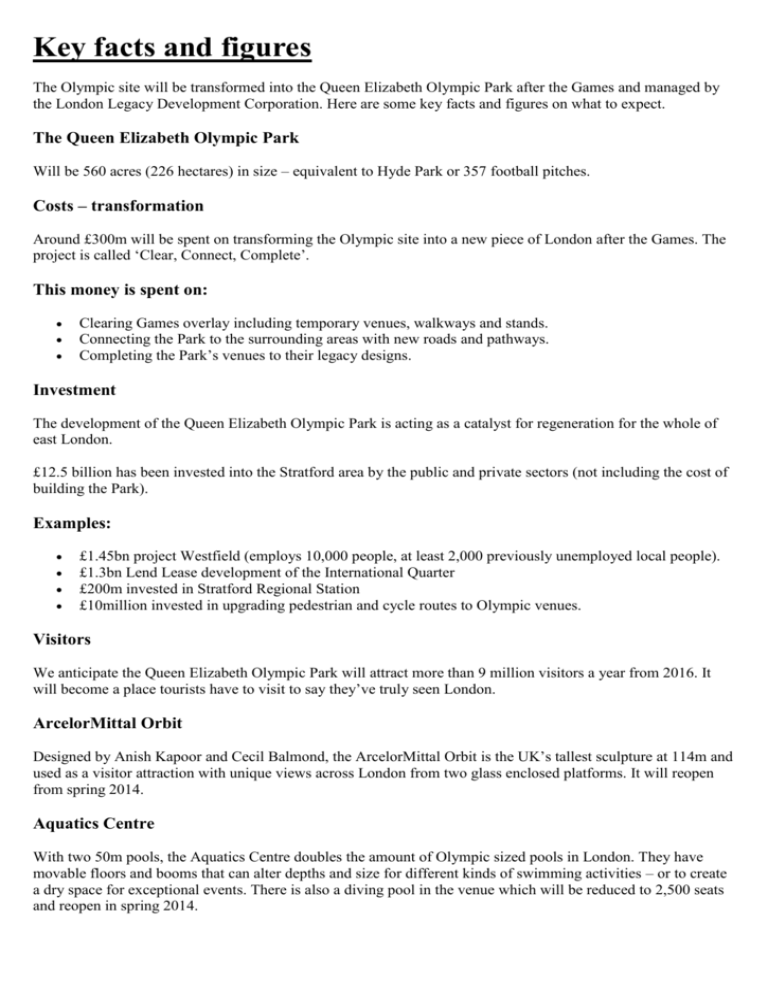
Key facts and figures The Olympic site will be transformed into the Queen Elizabeth Olympic Park after the Games and managed by the London Legacy Development Corporation. Here are some key facts and figures on what to expect. The Queen Elizabeth Olympic Park Will be 560 acres (226 hectares) in size – equivalent to Hyde Park or 357 football pitches. Costs – transformation Around £300m will be spent on transforming the Olympic site into a new piece of London after the Games. The project is called ‘Clear, Connect, Complete’. This money is spent on: Clearing Games overlay including temporary venues, walkways and stands. Connecting the Park to the surrounding areas with new roads and pathways. Completing the Park’s venues to their legacy designs. Investment The development of the Queen Elizabeth Olympic Park is acting as a catalyst for regeneration for the whole of east London. £12.5 billion has been invested into the Stratford area by the public and private sectors (not including the cost of building the Park). Examples: £1.45bn project Westfield (employs 10,000 people, at least 2,000 previously unemployed local people). £1.3bn Lend Lease development of the International Quarter £200m invested in Stratford Regional Station £10million invested in upgrading pedestrian and cycle routes to Olympic venues. Visitors We anticipate the Queen Elizabeth Olympic Park will attract more than 9 million visitors a year from 2016. It will become a place tourists have to visit to say they’ve truly seen London. ArcelorMittal Orbit Designed by Anish Kapoor and Cecil Balmond, the ArcelorMittal Orbit is the UK’s tallest sculpture at 114m and used as a visitor attraction with unique views across London from two glass enclosed platforms. It will reopen from spring 2014. Aquatics Centre With two 50m pools, the Aquatics Centre doubles the amount of Olympic sized pools in London. They have movable floors and booms that can alter depths and size for different kinds of swimming activities – or to create a dry space for exceptional events. There is also a diving pool in the venue which will be reduced to 2,500 seats and reopen in spring 2014. With an anticipated 800,000 visitors a year, the Aquatics Centre will be a thriving community asset where individuals, families, disabled people, school children and the UK’s best sporting talent can all swim and train under the same roof. London has bid to host the 2016 European Swimming Championships in the Aquatics Centre. Copper Box Known as the Copper Box during the 2012 Games, the Multi-Use Arena will host handball during the Olympic Games and Goalball during the Paralympic Games. Afterwards it will be transformed into a new venue with the flexible seating capacity and facilities for a wide range of community sports, competitions as well as cultural and business events. The Multi-Use Arena will be one of the first venues to reopen in summer 2013. It will be the third largest arena in London and could attract around 400,000 visitors a year. Stadium Built with flexibility in mind the Stadium will be reduced to 60,000 seats and could be used for major international championships and other sporting fixtures, concerts and attractions. It will be the new national centre for athletics and host the 2017 World Athletics Championships. The London Legacy Development Corporation is conducting a bidding process to secure additional uses for the Stadium. Press Centre and Broadcast Centre The Press Centre and Broadcast Centre will become a new commercial and employment site after the Games. Together they will offer 91,000sq m of business space in buildings that have been designed to ensure that they have the flexibility to be adapted for a wide range of uses. We anticipate more than 3,500 jobs will be based in the press and broadcast centre. Lee Valley VeloPark The stunning Velodrome will form the centrepiece of Lee Valley VeloPark, the first venue in the world to bring together track, road, mountain biking and BMX. A brand new one mile outdoor road cycle circuit and 6.5km of mountain bike trails are being constructed, along with a remodelled BMX track which will open up cycling to the widest possible group of people who’ll be able to enjoy what will be the finest cycling hub in the world. Opening in early 2014, the unrivalled venue will be owned and run by Lee Valley Regional Park Authority. The Velodrome is bidding to host the 2016 UCI World Track Cycling Championships – the biggest track cycling event before the Rio Olympics. Eton Manor Sports Complex Eton Manor hosted the Paralympic Wheelchair Tennis competition. After the Games it will be home to Lee Valley Hockey and Tennis Centre – an elegant new sports venue with outstanding facilities, two world class hockey pitches and 10 tennis courts, which will be owned and run by Lee Valley Regional Park Authority. It has already won the right to host the first major sports championship on Queen Elizabeth Olympic Park after the Games, the 2015 European Hockey Championships and is bidding for the 2014-16 ITF Wheelchair Tennis Masters Championship. Opening in spring 2014, the centre will combine community, club and grass roots use with major events. The London 2012 legacy The LLDC was set up three years before the Games in 2009. As a result, legacy plans for the Queen Elizabeth Olympic Park are more advanced than any previous host Olympic City. They include: Venues and Sport The future of six of the eight permanent venues has already been secured (Aquatics Centre, Orbit, MultiUse Arena, Olympic Village, Velodrome, Eton Manor). We are in advanced stages of work to complete the remaining two (Stadium and the Press and Broadcast Centre). The Park offer sporting programmes for everything from grass roots community use to high performance competitions. Price pledge –the cost of a swimming in the Aquatics Centre or court hire in the Multi-use Arena will be the same as that of a local leisure centre. Employment Up to 8,000 permanent jobs on the park by 2030 plus 2,500 temporary construction jobs Training and apprenticeships with a focus on opportunities for local people Venues such as the Press and Broadcast Centres have been developed so they can be adapted for commercial use after Games. New Neighbourhoods Five new neighbourhoods developed over 20 years Up to 8,000 new homes in addition to the 2,800 in the athletes’ village A target of 35% affordable housing * 3 schools 9 nurseries 3 health centres 29 playgrounds Transport Best connected most accessible place in Europe. Direct connections to a third of London’s rail and underground stations. There are nine public transport lines feeding into Stratford station; after the Games this will increase to ten. This means that a train could arrive at the station every 15 seconds. By 2016, it’s estimated that the number of passengers using Stratford station each morning will reach 83,000. Visitor Attraction Expected to become one of London’s Top 10 visitor destinations by 2020 attracting local, regional, national and international visitors. The Queen Elizabeth Olympic Park could attract more than 9million visitors per year from across London, the UK and abroad from 2016. Green Space Over 22 miles of interlinking pathways, waterways and cycle paths. 252 acres (102 hectares) of open space. 6.5 kms of rivers and canals running through the Park 111 acres (45 hectares) of biodiverse wildlife habitat on the Olympic Park, including reedbeds, grasslands, ponds and woodlands, with 525 bird boxes and 150 bat boxes.
